Catholic Customs
 |
 |
 |
 |
 |
 |
 |
The Christmas Eve Meal: Symbolic Courses
Housewives all over Europe prepared abundant baked goods, cheese, meats and homemade wine, beer and ale to last through the twelve days of Christmas. Everything had to be finished before Christmas Eve.
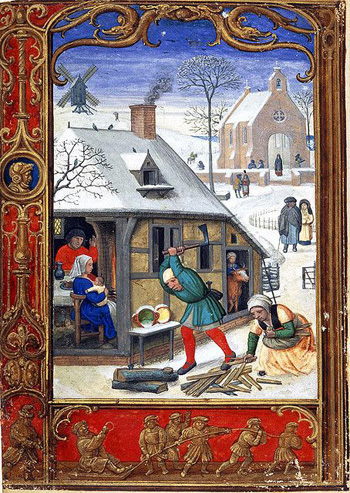 During the last couple weeks of Advent, markets were set up in cities selling handcrafted toys and decorations, meats, breads, pastries, sweets and live birds so that families could purchase their supplies for the Christmas festivities in advance.
During the last couple weeks of Advent, markets were set up in cities selling handcrafted toys and decorations, meats, breads, pastries, sweets and live birds so that families could purchase their supplies for the Christmas festivities in advance.
Farmers brought their plump geese, turkeys, chickens and other fowl to the city markets, which became a sea of colorful feathers and a “symphony” of clucking and gabbling birds. A few days before Christmas, the men butchered their prize pigs and poultry that would become the centerpiece of the meal.
In addition to culinary preparations, the house had to be thoroughly cleaned, tools and equipment cleared from the farm yard, and any borrowed items returned. Then, when the households and farms were in perfect order, the Christmas festivities would commence; for the house had to be fit to welcome the Holy Family.
A meal imbued with symbols
Christmas Eve is traditionally a fasting day that Catholics of old kept with strict adherence; this penance was gladly accepted in the spirit of joining with Our Lady and St. Joseph in their travails as they sought for a place to rest. In Germany, even the animals were obliged to join in the fast. (1)
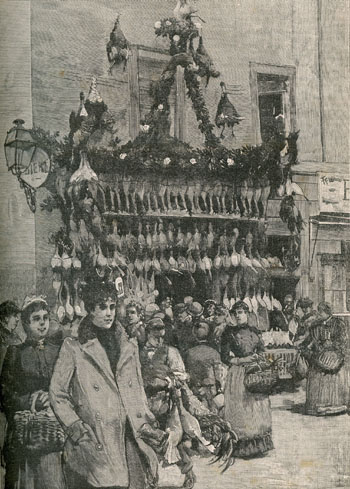 Italians observed a twenty-four hour fast beginning on sunset of December 23 and ending on sunset of Christmas Eve. (2) The Eastern Catholics kept a strict fast until the first Mass of Christmas, for which they prepared by praying before icons and reciting psalms.
Italians observed a twenty-four hour fast beginning on sunset of December 23 and ending on sunset of Christmas Eve. (2) The Eastern Catholics kept a strict fast until the first Mass of Christmas, for which they prepared by praying before icons and reciting psalms.
The expectant atmosphere reached its climax as darkness covered the land on Christmas Eve. The Christmas Eve meal, the most sacred meal of the year, was accompanied by ancient ceremonies and symbols passed on from generation to generation. Although this meal was one of abstinence, it was a joyful fast, a feast within a fast that was shared exclusively amongst family members and blood relations.
Tables laden with the best dishware and symbolic centerpieces were the fitting setting for the Christmas feast. In many countries, the tablecloth was homespun linen of the purest white.
Symbolic additions were often added to the table to remind everyone of the stable where Our Lord was born. In Poland, Hungary, Ukraine and other Slavic countries, stalks of grain were placed in the four corners of the dining room and straw was strewn under the white table cloth to commemorate the straw on which Our Lord was laid. Hungarian fathers took upon themselves the duty of solemnly placing the straw bundles in their proper places. (3)
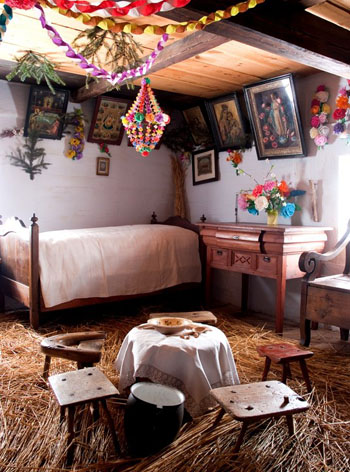 At times straw was even strewn on the floor. Many Bulgarian families ate their meal while seated on a tablecloth laid across the straw-strewn floor. (4)
At times straw was even strewn on the floor. Many Bulgarian families ate their meal while seated on a tablecloth laid across the straw-strewn floor. (4)
The Bethlehem stable was most vividly remembered in Alpine villages. In times past, the winter was so harsh in the Alpine villages of France that it was a custom in some of them to save fuel by having the whole village, including animals, gather in one stable or barn to stay warm in the evenings. The Réveillon meal was thus shared amongst the whole village in one stable. (5)
In Ukraine, Denmark, Czech and Poland, the mother set an extra place at the table in honor of the souls of the departed family members; that place would be offered to any stranger who came to the door, for perhaps it would be the Christ Child Himself. (6) In Egerszeg, Hungary, before the meal began, the head of the family prepared a separate plate that would later be distributed to the poor. (7)
As soon as the first star, symbolic of the Star of Bethlehem, could be seen in the night sky, families gathered at their tables, for the holiest night of the year had begun. Children from Slavic and Eastern European countries would watch expectantly for this star in order to triumphantly announce its appearance to the family.
The light of the star was reflected in the flames that burst in every home to light candles and fires on the hearth, table, Christmas tree or Nativity scene. (These lighting ceremonies are addressed in two previous articles here and here).
The fasting supper
The ancient ceremonies and customs of the Christmas Eve meal were revered as sacral traditions deserving of respect. In some parts of Russia, the whole meal was eaten in solemn silence. (8)
In Italy and Central and Eastern European countries, the main meal was eaten before Midnight Mass and it consisted of multiple courses of fish, meatless soups, vegetables and symbolic desserts. Nuts, fruit and grain were important ingredients for they symbolized health, fertility and a fruitful harvest. Old traditions determined the number of courses and sometimes even the number of ingredients in the dishes.
Lithuanians and Ukrainians served 12 meatless dishes in honor of the 12 Apostles, while the meatless meal of the Poles consisted of 7, 9, 11 or 13 courses; the traditional courses were grouped in threes: 3 soups, 3 fish dishes, 3 side dishes, and 3 desserts. For the Poles, the preferred number was 13, the number of men at the Last Supper. (9)
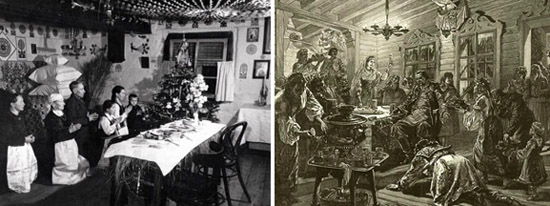 Italians from Abruzzo prepared either 7 (symbolic of the 7 Sacraments) or 9 (representing the Trinity multiplied by three) courses; many Hungarians also served 7. (10)
Fruit, especially dried fruit and apples, played a prominent role in these feasts, particularly in peasant families where it was a product of the family’s labor.
Italians from Abruzzo prepared either 7 (symbolic of the 7 Sacraments) or 9 (representing the Trinity multiplied by three) courses; many Hungarians also served 7. (10)
Fruit, especially dried fruit and apples, played a prominent role in these feasts, particularly in peasant families where it was a product of the family’s labor.
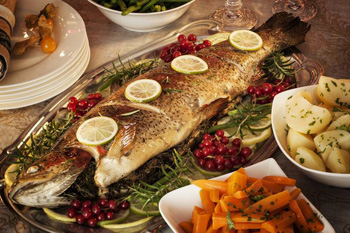
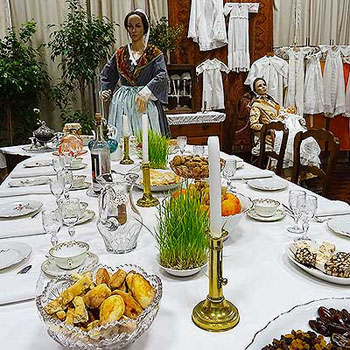 The Poles and Hungarians traditionally served compote made of 12 dried fruits in honor of the 12 Apostles. (11) The Mexicans also served fruits in a special Christmas Eve fruit salad, Ensalada de Nochebuena, which accompanied their fish dishes. (12)
The Poles and Hungarians traditionally served compote made of 12 dried fruits in honor of the 12 Apostles. (11) The Mexicans also served fruits in a special Christmas Eve fruit salad, Ensalada de Nochebuena, which accompanied their fish dishes. (12)
Italian families gathered around their tables to enjoy a festive fasting meal featuring various dishes of fish – often seven – that varied regionally in flavorings and presentation. One favorite dish was Capitoni (a type of large eel). (13)
Luxembourg families served a cold meatless buffet supper before Midnight Mass, while a large Spiced Carp graced German, Austrian and Hungarian tables. The Czechs and Slovaks also ate carp, often purchased by city-dwellers on the day before Christmas and kept in the bath tub until the time for baking. (14)
Scandinavian peoples ate a Christmas fasting supper of boiled cod, red wine and rice porridge. In Sweden, the supper featured a sun-cured cod prepared weeks in advance, known as lutfisk. (15)
Our Lady was specially honored in many regions. Her seven sorrows were commemorated in the Provençal meatless meal, the Gros Souper, that consisted of seven plain dishes of vegetables and fish. (16) Armenians joined Our Lady in spirit by eating a simple meal of fried fish, lettuce and boiled spinach on Christmas Eve, for this was the meal Our Lady was believed to have eaten on that night. (17)
Thus, uniting their sentiments of joyful expectation to the longings of the elect of the Old Testament, Catholics awaited that long-desired hour of Midnight for that moment of the greatest of wonders. Their hearts were wholly turned to honor Him Who leapt down from Highest Heaven to dwell with men on this poor earth.
Continued
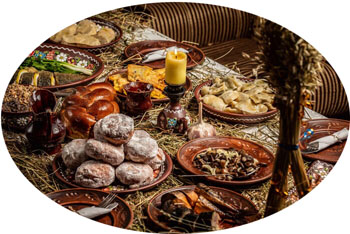

Posted December 29, 2023

Medieval men & women performing
their winter tasks
Farmers brought their plump geese, turkeys, chickens and other fowl to the city markets, which became a sea of colorful feathers and a “symphony” of clucking and gabbling birds. A few days before Christmas, the men butchered their prize pigs and poultry that would become the centerpiece of the meal.
In addition to culinary preparations, the house had to be thoroughly cleaned, tools and equipment cleared from the farm yard, and any borrowed items returned. Then, when the households and farms were in perfect order, the Christmas festivities would commence; for the house had to be fit to welcome the Holy Family.
A meal imbued with symbols
Christmas Eve is traditionally a fasting day that Catholics of old kept with strict adherence; this penance was gladly accepted in the spirit of joining with Our Lady and St. Joseph in their travails as they sought for a place to rest. In Germany, even the animals were obliged to join in the fast. (1)

Birds for sale at a Christmas market in Italy
The expectant atmosphere reached its climax as darkness covered the land on Christmas Eve. The Christmas Eve meal, the most sacred meal of the year, was accompanied by ancient ceremonies and symbols passed on from generation to generation. Although this meal was one of abstinence, it was a joyful fast, a feast within a fast that was shared exclusively amongst family members and blood relations.
Tables laden with the best dishware and symbolic centerpieces were the fitting setting for the Christmas feast. In many countries, the tablecloth was homespun linen of the purest white.
Symbolic additions were often added to the table to remind everyone of the stable where Our Lord was born. In Poland, Hungary, Ukraine and other Slavic countries, stalks of grain were placed in the four corners of the dining room and straw was strewn under the white table cloth to commemorate the straw on which Our Lord was laid. Hungarian fathers took upon themselves the duty of solemnly placing the straw bundles in their proper places. (3)

A Slavic peasant home with straw strewn on the floor
The Bethlehem stable was most vividly remembered in Alpine villages. In times past, the winter was so harsh in the Alpine villages of France that it was a custom in some of them to save fuel by having the whole village, including animals, gather in one stable or barn to stay warm in the evenings. The Réveillon meal was thus shared amongst the whole village in one stable. (5)
In Ukraine, Denmark, Czech and Poland, the mother set an extra place at the table in honor of the souls of the departed family members; that place would be offered to any stranger who came to the door, for perhaps it would be the Christ Child Himself. (6) In Egerszeg, Hungary, before the meal began, the head of the family prepared a separate plate that would later be distributed to the poor. (7)
As soon as the first star, symbolic of the Star of Bethlehem, could be seen in the night sky, families gathered at their tables, for the holiest night of the year had begun. Children from Slavic and Eastern European countries would watch expectantly for this star in order to triumphantly announce its appearance to the family.
The light of the star was reflected in the flames that burst in every home to light candles and fires on the hearth, table, Christmas tree or Nativity scene. (These lighting ceremonies are addressed in two previous articles here and here).
The fasting supper
The ancient ceremonies and customs of the Christmas Eve meal were revered as sacral traditions deserving of respect. In some parts of Russia, the whole meal was eaten in solemn silence. (8)
In Italy and Central and Eastern European countries, the main meal was eaten before Midnight Mass and it consisted of multiple courses of fish, meatless soups, vegetables and symbolic desserts. Nuts, fruit and grain were important ingredients for they symbolized health, fertility and a fruitful harvest. Old traditions determined the number of courses and sometimes even the number of ingredients in the dishes.
Lithuanians and Ukrainians served 12 meatless dishes in honor of the 12 Apostles, while the meatless meal of the Poles consisted of 7, 9, 11 or 13 courses; the traditional courses were grouped in threes: 3 soups, 3 fish dishes, 3 side dishes, and 3 desserts. For the Poles, the preferred number was 13, the number of men at the Last Supper. (9)

A Polish family kneels to begin the solemn Wigilia ceremonies;
right, Russian nobles celebrate a Christmas Eve meal

The Provençal seven course meal honoring Our Lady’s sorrows; below, Italian Christmas Eve meal with multiple fish courses

Italian families gathered around their tables to enjoy a festive fasting meal featuring various dishes of fish – often seven – that varied regionally in flavorings and presentation. One favorite dish was Capitoni (a type of large eel). (13)
Luxembourg families served a cold meatless buffet supper before Midnight Mass, while a large Spiced Carp graced German, Austrian and Hungarian tables. The Czechs and Slovaks also ate carp, often purchased by city-dwellers on the day before Christmas and kept in the bath tub until the time for baking. (14)
Scandinavian peoples ate a Christmas fasting supper of boiled cod, red wine and rice porridge. In Sweden, the supper featured a sun-cured cod prepared weeks in advance, known as lutfisk. (15)
Our Lady was specially honored in many regions. Her seven sorrows were commemorated in the Provençal meatless meal, the Gros Souper, that consisted of seven plain dishes of vegetables and fish. (16) Armenians joined Our Lady in spirit by eating a simple meal of fried fish, lettuce and boiled spinach on Christmas Eve, for this was the meal Our Lady was believed to have eaten on that night. (17)
Thus, uniting their sentiments of joyful expectation to the longings of the elect of the Old Testament, Catholics awaited that long-desired hour of Midnight for that moment of the greatest of wonders. Their hearts were wholly turned to honor Him Who leapt down from Highest Heaven to dwell with men on this poor earth.
Continued

An Eastern European Christmas Eve table
- Mary P. Pringle and Clara A. Urann, Yule-tide in Many Lands (Boston: Lothrop Lee and Shepard Co., 1916), p. 70.
- Carol Field, Celebrating Italy (New York: William Morrow and Company, 1990), p. 256.
- https://www.arcanum.com/hu/online-kiadvanyok/MagyarNeprajz-magyar-neprajz-2/vii-nepszokas-nephit-nepi-vallasossag-A33C/szokasok-A355/jeles-napok-unnepi-szokasok-A596/december-A912/december-24-karacsony-vigiliaja-adam-eva-napja-A9B2/karacsonyi-asztal-A9B3/
- Mercia MacDermott, Bulgarian Folk Customs (London and Philadelphia: Jessica Kingsley Publishers, 1998), p. 165.
- Christmas in France (Chicago, Illinois: World Book-Childcraft International, 1980), p. 46
- https://sspp.ca/our-faith/feast-day-traditions/
- https://www.arcanum.com/hu/online-kiadvanyok/MagyarNeprajz-magyar-neprajz-2/vii-nepszokas-nephit-nepi-vallasossag-A33C/szokasok-A355/jeles-napok-unnepi-szokasok-A596/december-A912/december-24-karacsony-vigiliaja-adam-eva-napja-A9B2/karacsonyi-asztal-A9B3/
- Polina Rozhnova, A Russian Folk Calendar (Moscow: Novosti, 1992), p. 22.
- Sophie Hodorowicz Knab, Polish Customs, Traditions, and Folklore (New York: Hippocrene Books, 1996), p. 39.
- Carol Field, Celebrating Italy (New York: William Morrow and Company, 1990), p. 254. See also: https://www.arcanum.com/hu/online-kiadvanyok/MagyarNeprajz-magyar-neprajz-2/vii-nepszokas-nephit-nepi-vallasossag-A33C/szokasok-A355/jeles-napok-unnepi-szokasok-A596/december-A912/december-24-karacsony-vigiliaja-adam-eva-napja-A9B2/karacsonyi-asztal-A9B3/
- Katherine Burton and Helmut Ripperger, Feast Day Cookbook (Catholic Authors Press, 2005), p. 157.
- Evelyn Birge Vitz, A Continual Feast (San Fransisco: Ignatius Press, 1985), p. 125.
- Mary P. Pringle and Clara A. Urann, Yule-tide in Many Lands (Boston: Lothrop Lee and Shepard Co., 1916), p. 137.
- https://www.myczechrepublic.com/czech_culture/czech_holidays/christmas.html
- Lee Wyndham, Holidays in Scandinavia (Champaign, Illinois: Garrard Publishing Company, 1975), p. 79.
- https://www.marvellous-provence.com/arts-and-traditions/traditions/christmas-in-provence/christmas-foods
- Katherine Burton and Helmut Ripperger, Feast Day Cookbook (Catholic Authors Press, 2005), p. 159.

Posted December 29, 2023
______________________
______________________
 |
 |
 |
 |
 |
 |


